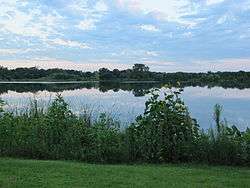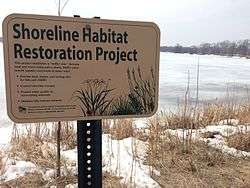Lake Hiawatha
| Lake Hiawatha | |
|---|---|
 Lake Hiawatha in July 2010 | |
| Location |
Minneapolis, Minnesota, United States |
| Coordinates | 44°55′15″N 093°14′11″W / 44.92083°N 93.23639°WCoordinates: 44°55′15″N 093°14′11″W / 44.92083°N 93.23639°W |
| Primary inflows | Minnehaha Creek |
| Primary outflows | Minnehaha Creek |
| Basin countries | United States |
| Surface area | 53.5 acres (217,000 m2) |
| Max. depth | 33 ft (10 m) |
| Surface elevation | 814 ft (248 m) |
| Frozen | winter |


Lake Hiawatha is located just north of Lake Nokomis in Minneapolis, Minnesota. It was purchased by the Minneapolis park system in 1922 for $550,000. At that time the lake was a marsh known as Rice Lake, but over four years, the park system transformed the wetland into a lake surrounded by a park.
Recreation
The lake and park have a fishing dock, wading pool, tennis courts, softball diamonds. There is a recreation center that hosts activities. The lake borders a municipal golf course. In the winter the park sets up ice and hockey rinks. There is a bike and walking path starting at Lake Hiawatha which veers onto Lake Nokomis or winds down the Minnehaha Creek right to the mouth of the Minnehaha Falls.
Lake Hiawatha is one of the few lakes through which the Minnehaha Creek flows, and the last one before it reaches Minnehaha Falls and then the Mississippi River.
Fish
The lake contains black bullhead, black crappie, bluegill, bowfin, carp, golden shiner, green sunfish, hybrid sunfish, largemouth bass, northern pike, pumpkinseed, walleye, white sucker, yellow bullhead, and yellow perch.[1] Some fish consumption guideline restrictions have been placed on the lake's bluegill and northern pike due to mercury and/or PCB contamination.[1]
Water quality
Lake Hiawatha has much more garbage than any other Minneapolis lake. The lake is a stormwater outlet for the Corcoran, Central, Bryant, and Northrop neighborhoods, as well as the park's golf course.[2]
The Lake Hiawatha beach has been occasionally closed, such as in August 2014, because of unsafe levels of E. coli.[3]
Lake Hiawatha has been officially declared infested by zebra mussels since 2010, and in September 2013 park workers began finding mussels.[4]
See also
References
- 1 2 "Lake information report: Minnesota DNR". MN DNR. MN DNR. 2007-06-18.
- ↑ Dupuy, Beatrice (July 11, 2015). "1,500 pounds of trash later, man's quest to keep Minneapolis lake clean continues". Minneapolis Star Tribune. Retrieved July 11, 2015.
- ↑ "Popular beaches in Minneapolis closed due to E. coli levels". CBS Minnesota. August 5, 2014. Retrieved July 11, 2015.
- ↑ McAuliffe, Bill (September 6, 2013). "Zebra mussels found in Lake Hiawatha". Minneapolis Star Tribune. Retrieved July 11, 2015.
External links
| Wikimedia Commons has media related to Lake Hiawatha Park. |